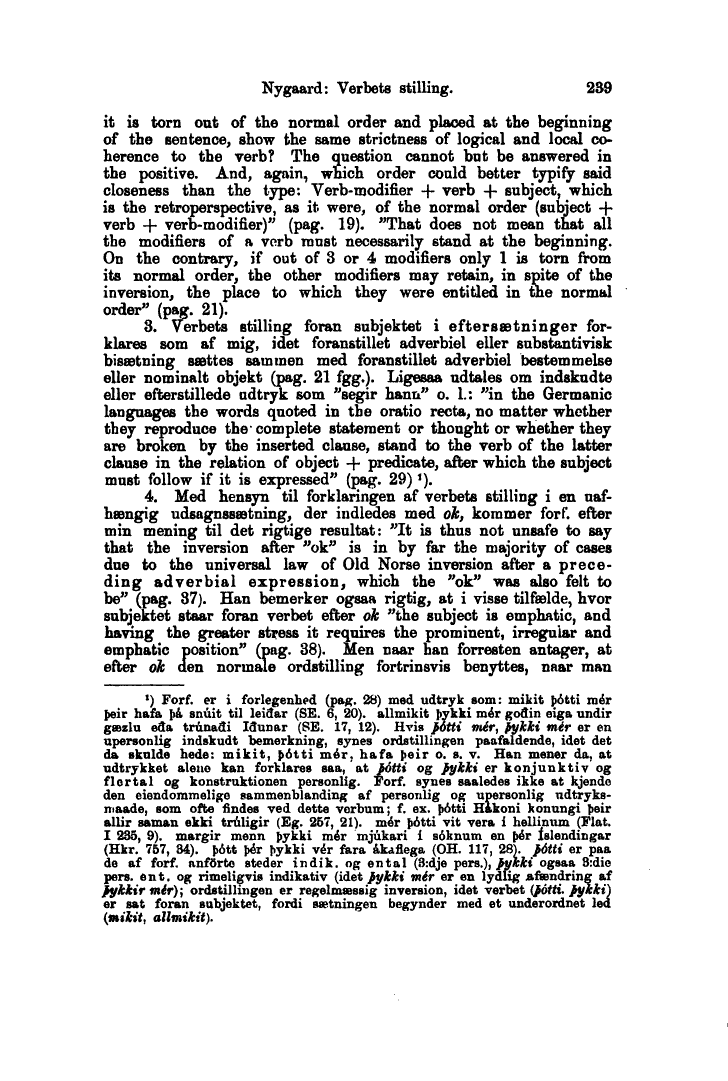
Full resolution (TIFF) - On this page / på denna sida - Sidor ...

<< prev. page << föreg. sida << >> nästa sida >> next page >>
Below is the raw OCR text
from the above scanned image.
Do you see an error? Proofread the page now!
Här nedan syns maskintolkade texten från faksimilbilden ovan.
Ser du något fel? Korrekturläs sidan nu!
This page has never been proofread. / Denna sida har aldrig korrekturlästs.
Nygaard: Verbets stilling.
259
it is torn out of the normal order and placed at the beginning
of the sen ten ce, show the same strictness of logicai and local
co-herence to the verb? The question cannot bat be answered in
the positive. And, again, which order could better typify said
closeness than the type: Verb-njodifier + v©rb + subject, which
is the retroperspective, as it were, of the normal order (subject +
verb + verb-modifier)" (pag. 19). "That does not mean that all
the modifiers of a verb ranst necessarily stand at the beginning.
Ön the contrary, if out of 3 or 4 modifiers only 1 is torn from
its normal order, the other modifiers may retain, in spite of the
inversion, the place to which they were entitled in the normal
order" (pag. 21).
3. Verbets stilling foran subjektet i eftersætninger
forklares som af mig, idet foranstillet adverbiel eller substantivisk
bisætning sættes sammen med foranstillet adverbiel bestemmelse
eller nominalt objekt (pag. 21 fgg.). Ligesaa udtales om indskudte
eller efterstillede udtryk som "segir hann" o. 1.: "in the Germanic
languages the words quoted in the oratio recta, no matter whether
they reproduce the complete statement or thonght or whether they
are broken by the inserted clanse, stand to the verb of the latter
clause in the relation of object + predicate, after which the subject
must follow if it is expressed" (pag. 29)J).
4. Med hensyn til forklaringen af verbets stilling i en
uafhængig udsagnssætning, der indledes med ok, kommer forf’. efter
min mening til det rigtige resultat: "It is thus not unsafe to say
that the inversion after "ok" is in by far the majority of cases
due to the universal law of Old Norse inversion after a
prece-ding adverbial expression, which the "ok" was also felt to
be" (pag. 37). Han bemerker ogsaa rigtig, at i visse tilfælde, hvor
subjektet staar foran verbet efter ok "the subject is emphatic, and
having the greater stress it requires the prominent, irregular and
emphatic position" (pag. 38). Men naar han forresten antager, at
efter ok den normale ordstilling fortrinsvis benyttes, naar man
l) Forf. er i forlegenhed (pag. 28) med udtryk som: mikit pátti mér
J>eir hafa |)á snuit til leictar (SE. 6, 20). allmikit [>ykki mér goctin eiga undir
gæzlu ecta trunadi Idun ar (SE. 17, 12). Hvis fétti mér, fykki mér er en
upersonlig indskudt bemerkning, synes ordstillingen paafaldende, idet det
da skulde hede: mikit, J>6tti mér, hafa I>eir o. s. v. Han mener da, at
udtrykket alene kan forklares saa, at fötti og fykki er konjunktiv og
flor tal og konstruktionen personlig. Forf. synes saaledes ikke at kjende
den eiendommelige sammenblanding af personlig og upersonlig
Udtryksmaade, som ofte findes ved dette verbum; f. ex. fiåtti Hakoni konungi f>eir
allir saman ekki truligir (Eg. 257, 21). mér J>6tti vit vera i hellinum (Flat.
I 235, 9). margir menn J>ykki mér mjukari i såknum en f>ér Islendingar
(Hkr. 757, 34). f>6tt |>ér |>ykki vér fara ákaflega (OH. 117, 28). fötti er paa
de af forf. anförto steder indik. og ental (3:dje pers.), fykki ogsaa 3:die
pers. ent. og rimeligvis indikativ (idet fykki mér er en lydlig afændring af
fykkir mér); ordstillingen er regelmæssig inversion, idet verbet {fötti. fykki)
er sat foran subjektet, fordi sætningen begynder med et underordnet led
(mikit, allmikit).
<< prev. page << föreg. sida << >> nästa sida >> next page >>